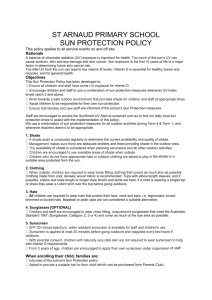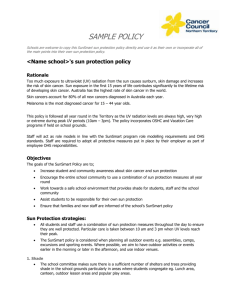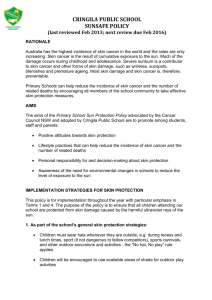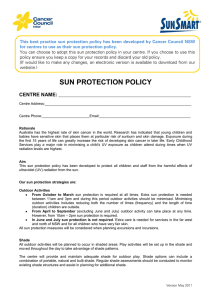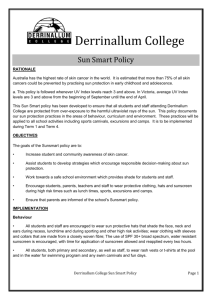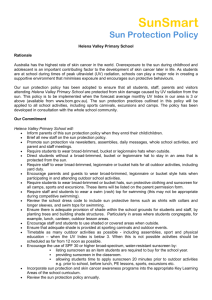Early Childhood Education and Care Sun Protection Policy
advertisement
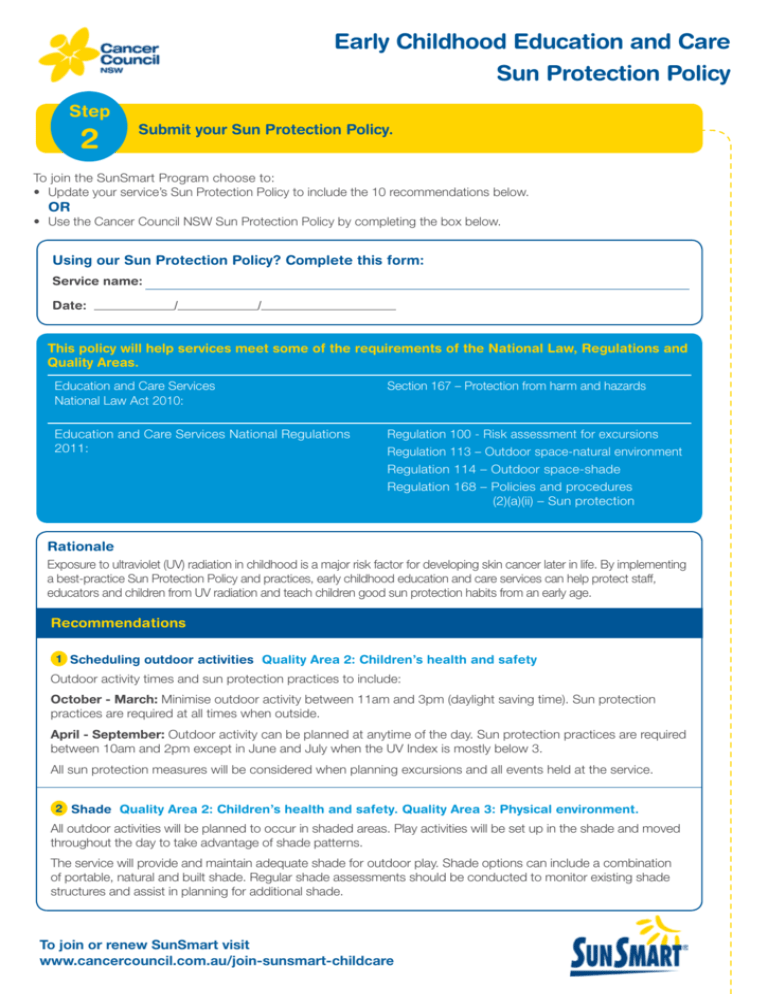
Early Childhood Education and Care Sun Protection Policy Step 2 Submit your Sun Protection Policy. To join the SunSmart Program choose to: • Update your service’s Sun Protection Policy to include the 10 recommendations below. OR • Use the Cancer Council NSW Sun Protection Policy by completing the box below. Using our Sun Protection Policy? Complete this form: Service name: Date: / / This policy will help services meet some of the requirements of the National Law, Regulations and Quality Areas. Education and Care Services National Law Act 2010: Section 167 – Protection from harm and hazards Education and Care Services National Regulations 2011: Regulation 100 - Risk assessment for excursions Regulation 113 – Outdoor space-natural environment Regulation 114 – Outdoor space-shade Regulation 168 – Policies and procedures (2)(a)(ii) – Sun protection Rationale Exposure to ultraviolet (UV) radiation in childhood is a major risk factor for developing skin cancer later in life. By implementing a best-practice Sun Protection Policy and practices, early childhood education and care services can help protect staff, educators and children from UV radiation and teach children good sun protection habits from an early age. Recommendations 1 Scheduling outdoor activities Quality Area 2: Children’s health and safety Outdoor activity times and sun protection practices to include: October - March: Minimise outdoor activity between 11am and 3pm (daylight saving time). Sun protection practices are required at all times when outside. April - September: Outdoor activity can be planned at anytime of the day. Sun protection practices are required between 10am and 2pm except in June and July when the UV Index is mostly below 3. All sun protection measures will be considered when planning excursions and all events held at the service. 2 Shade Quality Area 2: Children’s health and safety. Quality Area 3: Physical environment. All outdoor activities will be planned to occur in shaded areas. Play activities will be set up in the shade and moved throughout the day to take advantage of shade patterns. The service will provide and maintain adequate shade for outdoor play. Shade options can include a combination of portable, natural and built shade. Regular shade assessments should be conducted to monitor existing shade structures and assist in planning for additional shade. To join or renew SunSmart visit www.cancercouncil.com.au/join-sunsmart-childcare vRecommendations 3 Hats Quality Area 2: Children’s health and safety Staff, educators and children are required to wear sun-safe hats that protect their face, neck and ears. Sun-safe hats include: • bucket hats with a deep crown and brim size of at least 5cm (adults 6cm) • broad-brimmed hats with a brim size of at least 6cm (adults 7.5cm) • legionnaire style hats. Please note: Baseball caps or visors are not sun-safe hats. Children without a sun-safe hat are required to play in an area protected from the sun (e.g. under shade, veranda or indoors) or will be provided with a spare hat. 4 Clothing Quality Area 2: Children’s health and safety Staff, educators and children are required to wear sun-safe clothing that covers as much of the skin (especially the shoulders, back and stomach) as possible. This includes wearing: • loose fitting shirts and dresses with sleeves and collars or covered neckline • longer style skirts, shorts and trousers. Please note: Midriff, crop or singlet tops are not sun-safe clothing. Children without sun-safe clothing are required to play in an area protected from the sun (e.g. under shade, veranda or indoors) or will be provided with spare clothing. 5 Sunscreen Quality Area 2: Children’s health and safety Staff, educators and children are required to apply at least SPF30+ broad-spectrum water-resistant sunscreen 20 minutes before going outdoors and reapply every 2 hours. Sunscreen is stored in a cool, dry place and the expiry date is monitored. 6 Babies Quality Area 2: Children’s health and safety Babies under 12 months should not be exposed to direct sunlight and are to remain in full shade when outside. They are required to wear sun-safe hats and clothing, and small amounts of SPF30+ broad-spectrum water-resistant sunscreen suitable for babies may be applied to their exposed skin. 7 Role Modelling Quality Area 5: Relationships with children Staff and educators are required to act as role models and demonstrate sun-safe behaviour by: • wearing a sun-safe hat, clothing and sunscreen, and using shade • wearing sunglasses (optional) that comply with the Australian Standard 1067 (Sunglasses: Category 2, 3 or 4) • encouraging families and visitors to role model positive sun-safe behaviour when at the service. 8 Education and Information Quality Area 1: Educational program and practice. Quality Area 5: Relationships with children. Quality Area 6: Collaborative partnerships with families and communities. Services are required to incorporate sun protection information regularly into learning programs and communicate information to staff, educators, families and visitors. Further information is available from the Cancer Council NSW website www.cancercouncil.com.au/sunsmart. 9 Policy Availability Quality Area 6: Collaborative partnerships with families and communities. Quality Area 7: Leadership and service management. 10 Review Quality Area 7: Leadership and service management Management, staff and educators will regularly monitor and review the effectiveness of the Sun Protection Policy. The service’s Sun Protection Policy must be updated and submitted to Cancer Council NSW every two years to maintain SunSmart status. e: sunsmartchildcare@nswcc.org.au f: (02) 8302 3529 SunSmart Infoline: (02) 9334 1761 SunSmart Program Cancer Council NSW PO BOX 572 Kings Cross NSW 1340 CAN10375CS 09/2013 The Sun Protection Policy, updates and requirements will be made available to staff, educators, families and visitors.
